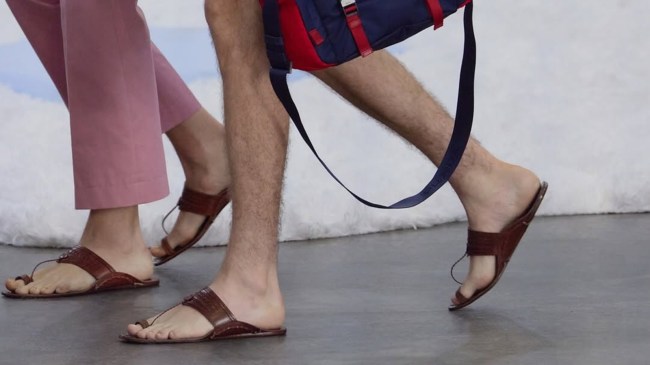Opinion Fake Birkenstocks bother me, but so does the appropriation of Kolhapuris by Prada
Birkenstocks to Prada: From a courtroom battle in Delhi to the runway controversy in Milan, the fight over who owns design is about recognition, access, and fairness in fashion.
 From Kolhapuris on Prada runway to Birkenstocks taking counterfeiters to court, the fight for credit in the fashion industry is not a simple path. (Representational)
From Kolhapuris on Prada runway to Birkenstocks taking counterfeiters to court, the fight for credit in the fashion industry is not a simple path. (Representational) Let me start by saying, I’m not the kind of person who gets sentimental about shoes. But I am a walking contradiction when it comes to Birkenstocks: I care more than I should.
My personal collection sits somewhere between “minimalist” and “mildly obsessed”. And yes, I’ve worn them to weddings, airports, and one regrettable hike. So when I heard that Birkenstock had taken counterfeiters to court in India, I felt a strange rush of vindication.
The Delhi High Court stepped in after the German brand filed a lawsuit against small-scale traders and factories accused of manufacturing fakes. Legal commissioners were dispatched to New Delhi and Agra to sniff out suspect sandals and confiscate inventory. The judge, after reviewing images of the counterfeits, didn’t mince his words; he called them “cheap knockoffs” likely to deceive the public.
As someone who has worn both — the real and the “inspired” version — I can confirm, there’s a difference. A big one. But this isn’t just about foam soles and buckles. It’s about who gets to make what, who profits from it, and what it means to buy into a brand — literally and metaphorically.
The knockoff problem no one wants to admit
Here’s the thing about counterfeit fashion. No one really talks about it unless a raid or a court case happens or an influencer gets called out for flaunting fakes. But it’s everywhere. Scroll through any shopping app and you’ll find suspiciously familiar designs with only slightly altered names: “Birkanstocks” “Brkenstok” and even bigger brands selling the shoes minus the names with their own branding. It’s the footwear version of “Ctrl+C, Ctrl+V”, with none of the original comfort.
 The case adds to a growing list of high-profile intellectual property battles in India’s footwear sector. (Express Photos)
The case adds to a growing list of high-profile intellectual property battles in India’s footwear sector. (Express Photos)
I’d love to pretend I’ve always been loyal to the real deal, but the truth is, I haven’t. A few years ago, lured by a Rs 999 price tag, I bought what I thought was a passable knockoff from Bangkok. It took me exactly 11 days to realise the straps would rather peel than support me, and the arch was about as flat as my salary increment. Lesson learned.
But let’s not be dismissive of why fakes exist. Original Birkenstocks are expensive. Rs 7,000 to Rs 15,000 for sandals isn’t “everyday affordable” in a country where footwear is often bought with the same mentality as umbrella purchases — seasonal, practical, and cheap. Many people simply can’t justify the price even if they admire the design. And for some, buying a knockoff isn’t a moral failing — it’s the only way to access a look they admire but can’t afford.
That doesn’t mean counterfeiting is okay. But it does mean we need to understand the gap between admiration and access. And that brings me to Prada.
When high fashion forgets its footnotes
Around the same time Birkenstock was busy fighting copycats, Prada walked into a controversy of its own. On the runway of its spring/summer collection, the luxury brand showcased a line of sandals that looked suspiciously like Kolhapuri chappals – traditional Maharashtrian leather slippers that have existed for centuries and are crafted by artisans who rarely make headlines, let alone international fashion credits.
Initially, there was no mention of the Indian design influence. Just a pair of runway-ready “new” sandals made of leather. The backlash was swift — and deserved. Eventually, Prada acknowledged the Indian inspiration behind the design. But the episode sparked an uncomfortable question: When does inspiration become appropriation? And why does global recognition often skip the hands that do the real work?
It’s easy to point fingers at street vendors selling fake Birkenstocks, but what happens when billion-dollar fashion houses like Prada borrow from regional crafts and forget to say thank you? Counterfeiting is illegal. But cultural erasure? Apparently, just “creative direction”.
 Birkenstock sandals are pictured in Birkenstock store in Frankfurt, Germany, Oct. 4, 2023. (AP Photo/Michael Probst, File)
Birkenstock sandals are pictured in Birkenstock store in Frankfurt, Germany, Oct. 4, 2023. (AP Photo/Michael Probst, File)
Owning design, sharing credit
Don’t get me wrong – brands have a right to protect their designs. If someone’s selling a fake with your name on it, you should have legal recourse. The Delhi High Court did the right thing by treating Birkenstock’s complaint seriously. Design theft is real, and for every cheap knockoff sold, there’s a craftsman, a shoemaker, a small business that’s being undercut.
But protecting design can’t just be about gatekeeping exclusivity. It also needs to be about recognising roots — whether it’s Birkenstock’s orthopaedic footbed or the cultural lineage of Indian leatherwork that global brands, like Prada and Louis Vuitton, are suddenly “rediscovering”. Credit can’t only flow upwards. It needs to travel back to communities that have shaped design long before fashion houses ever spotted a trend.
Originals matter, but so does access
So where does that leave someone like me? A Birkenstock loyalist who believes in buying the real thing, but also flinches at the price tag? Torn, mostly. Because while I’ll always argue that originals feel better (they do), I also know that pricing people out of quality design only widens the gap that counterfeits exploit.
What we need is more transparency. More collaborations that bring original artisans into the spotlight. Local tie-ups that facilitate India-specific pricing. The realisation that “high fashion” doesn’t mean leaving tradition behind. And yes, more brands that acknowledge that not everyone can afford Rs 15,000 sandals, no matter how well they’re moulded.
Until then, I’ll keep walking my very real Birks, proudly, comfortably, and with just a touch of arch-supported smugness. But I’ll also be keeping an eye on the runway, and hoping that the next time a Kolhapuri goes global, the artisan who made it isn’t left in the dust.
stela.dey@indianexpress.com






